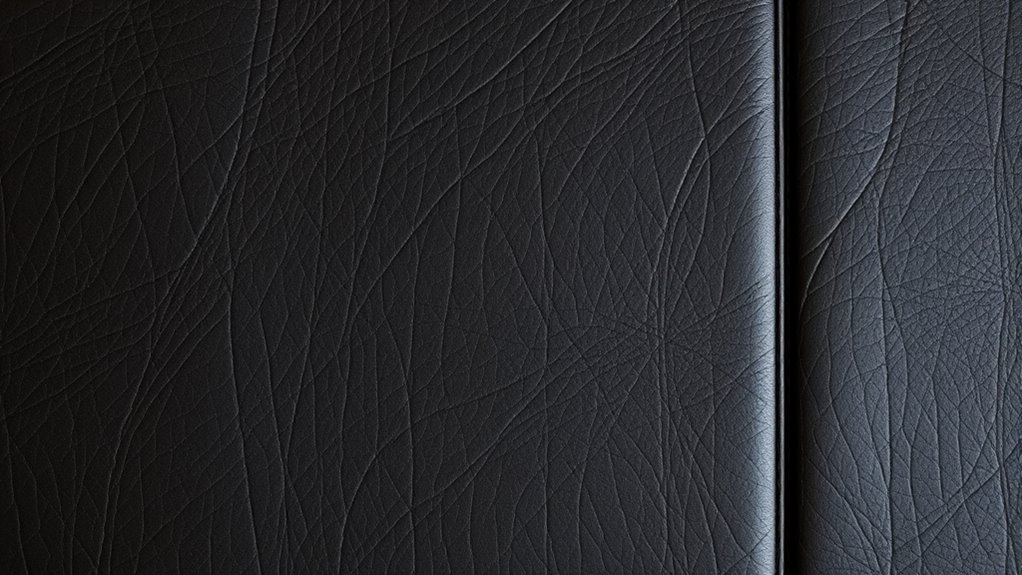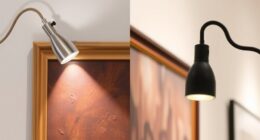To care for your leather wall panels, regularly dust with a soft microfiber cloth and use a leather-specific cleaner for stubborn stains. Keep humidity between 40-50% to prevent damage from swelling or cracking, and manage it with a dehumidifier or humidifier as needed. Remember, proper cleaning and climate control help maintain the panels’ beauty and longevity. Want to guarantee your panels stay pristine? Keep exploring for expert tips on preserving their luxurious look.
Key Takeaways
- Regularly clean leather panels with a soft, damp microfiber cloth and avoid harsh chemicals.
- Use leather conditioner every few months to maintain suppleness and prevent cracking.
- Keep indoor humidity between 40% and 50% to prevent swelling, warping, or cracking.
- Utilize dehumidifiers or humidifiers based on climate conditions to control moisture levels effectively.
- Monitor and adjust environmental conditions promptly to preserve the panels’ appearance and structural integrity.

Leather wall panels are an increasingly popular choice for elevating interior design, offering a luxurious and sophisticated look. Their rich texture and timeless appeal can transform any space, but they do require proper care to maintain their beauty. Understanding cleaning techniques and humidity control tips will help you preserve your panels and ensure they remain a stunning feature in your home or office.
When it comes to cleaning leather wall panels, you want to use techniques that are gentle yet effective. Avoid harsh chemicals or abrasive cleaners, as these can damage the leather’s surface. Instead, opt for a soft, damp cloth—preferably microfiber—to wipe down the panels regularly. This removes dust, dirt, and fingerprints without stripping away the natural oils. For more stubborn spots or stains, use a leather-specific cleaner or a mixture of mild soap and water. Always test any cleaning solution on a small, inconspicuous area first to prevent discoloration or damage. Remember, never soak the leather; excess moisture can lead to warping or mold growth. After cleaning, dry the surface with a soft towel and consider applying a leather conditioner every few months. This helps maintain suppleness and prevents cracking, keeping your panels looking pristine over time.
Humidity control is equally important in preserving leather wall panels. Leather is a natural material that reacts to environmental changes, especially moisture levels. Too much humidity can cause the leather to swell, warp, or develop mold, while overly dry conditions might lead to brittleness and cracking. To prevent these issues, you should aim to keep indoor humidity levels between 40% and 50%. Using a dehumidifier in humid climates can help maintain a stable environment, while a humidifier can add moisture during dry seasons. Proper ventilation also plays a key role—ensure your space has good airflow to avoid dampness buildup. If you notice any signs of excessive moisture or dryness, take immediate action to adjust the room’s humidity, as prolonged exposure to unfavorable conditions can considerably damage your leather panels over time. Consistent climate control, combined with careful cleaning techniques, will extend the lifespan of your panels and keep them looking their best.
Frequently Asked Questions
Can Leather Wall Panels Be Cleaned With Water?
You shouldn’t clean leather wall panels with water directly, as it can cause water damage and harm the leather. Instead, use a damp cloth with a gentle cleaning solution designed for leather. Avoid excessive moisture, and never soak the panels. Regularly wiping with a slightly damp cloth helps maintain their appearance and prevents damage. Always test cleaning solutions on a small, hidden area first to ensure they won’t harm the leather.
How Often Should I Condition Leather Panels?
Your leather panels deserve a hero’s treatment—conditioning every 6 to 12 months keeps them looking brand new. Proper leather care involves regular conditioning to prevent cracking and maintain their rich appearance. Keep humidity levels steady to avoid damage, as fluctuations can cause leather to warp or crack. By sticking to this schedule and controlling humidity, you’ll guarantee your leather panels stay stunning, resilient, and full of life for years to come.
Are Leather Panels Resistant to Mold and Mildew?
Leather wall panels are generally resistant to mold and mildew if properly maintained. To enhance mold prevention and mildew resistance, keep the humidity levels in your space below 60% and ensure good ventilation. Regularly clean the panels with a damp cloth and avoid excessive moisture. Proper care minimizes mold growth and preserves their appearance, so stay attentive to humidity and cleanliness to maintain their durability and aesthetic appeal.
What Temperature Range Is Safe for Leather Panels?
Sure, you’d think leather panels love extreme temperatures, but they actually prefer a cozy 60-75°F range. Sudden temperature fluctuations can accelerate leather aging and cause cracking, so avoid drafts or heat sources. Keep the environment stable to preserve their beauty and durability. Ironically, the more you protect them from temperature swings, the longer they’ll stay looking luxurious. Your leather panels will thank you with timeless elegance.
Can Leather Panels Be Installed Outdoors?
You can’t install leather wall panels outdoors because they lack outdoor durability and weather resistance. Exposure to elements like rain, sun, and humidity damages leather, causing it to crack, fade, or warp. To preserve their appearance and integrity, keep leather panels indoors or in protected areas. If outdoor installation is necessary, consider using specially treated weather-resistant materials designed for outdoor durability instead.
Conclusion
To keep your leather wall panels looking their best, remember to maintain proper humidity and clean them regularly. Did you know that leather can absorb up to 30% of its weight in moisture? This makes controlling humidity essential to prevent damage like cracking or mold. By staying attentive to these care tips, you’ll enjoy the rich, elegant look of your panels for years to come. Protect your investment and keep your space stylish and comfortable.









